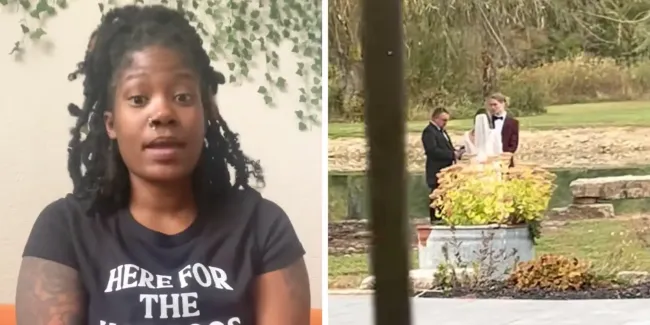The Uninvited Witness: How a Viral Wedding Removal Exposed Event Planning Failure, Racial Microaggression, and Digital Shaming
A viral TikTok video showing the public removal of two Black guests from a wedding has ignited global debate on event planning ethics, racial microaggressions, and the power of digital accountability.
Introduction: The Viral Firestorm at the Altar
On October 27, 2025, TikTok creator @damnnnndee posted a now-viral video (3.7M+ views) documenting her and her mother’s humiliating public removal from a coworker’s wedding ceremony. What began as a celebration quickly became a public spectacle of exclusion, sparking a nationwide conversation about professional failure, racial bias, and digital justice.
The organizers claimed the guests were “only invited to the reception,” yet they were publicly escorted out mid-vows—the most sacred part of the ceremony. Adding to the distress, they were reportedly the only Black attendees, amplifying public concern that this was not just poor coordination, but a case of racial microaggression disguised as logistical enforcement.
Part I: Professional Failure in Event Planning
When Protocol Collapses: Discretion vs. Public Humiliation
Event planners hold a duty to maintain the emotional integrity of the occasion. When guest confusion arises, disputes should be handled privately, discreetly, and respectfully. In this case, the opposite occurred.
The wedding coordinator’s choice to interrupt the ceremony and confront the guests publicly violated every core rule of event professionalism. Instead of calming the situation, she reportedly chastised the guest’s mother with, “Please don’t be disrespectful,” escalating the conflict from a logistical mix-up to a moral accusation.
This error not only humiliated the guests—it disrupted the entire ceremony and permanently damaged the event’s atmosphere.
| Best Practice | Observed Action | Professional Impact |
|---|---|---|
| Handle disputes privately and discreetly | Public removal mid-vows | Public humiliation and viral backlash |
| Maintain professionalism and calm tone | Coordinator used chastising language | Escalation and emotional harm |
| Use a designated staff member to manage issues away from ceremony | Mid-ceremony confrontation by coordinator | Loss of event control and reputation damage |
The result was a textbook example of catastrophic professional failure—a logistical issue amplified into a viral public shaming.
@damnnnndee Imagine being invited to a #wedding just for this to happen .... #fyp ♬ original sound - DamnnnnDee
Part II: The Etiquette Gap and Invitation Breakdown
The Risk of “Reception-Only” Invitations
Many couples hold intimate ceremonies followed by larger receptions. However, such arrangements require flawless communication. Reception-only guests must be clearly informed and made to feel valued, not excluded.
In this case, the confusion stemmed from a failure in invitation design and event timing. Evidence suggests that the guests either received the wrong information or were welcomed without verification—leading them to believe they were entitled to attend the full event.
Professional wedding planners typically use distinct invitation sets and website access gates to prevent this very confusion. Here, those safeguards failed—forcing the coordinator to enforce boundaries in real-time, during the ceremony itself.
Part III: When Exclusion Becomes a Racial Microaggression
Public Removal as Social Injury
Being publicly removed from a wedding—especially as the only Black guests—was experienced by the victims as a profound social and psychological injury. The act communicated, implicitly, that they did not belong.
Microaggressions often manifest as small, ambiguous acts that carry deeply racialized undertones. Publicly ejecting only the Black guests during a sacred moment was perceived as a racialized assertion of control.
Sociological research shows that Black individuals are more frequently subjected to suspicion and hypervigilant treatment in public and professional settings. Even if not overtly racist, the outcome remains discriminatory because it enforces exclusionary norms.
This moment thus became a symbolic act of gatekeeping, reinforcing racial boundaries within a private social sphere under the guise of “protocol enforcement.”
Part IV: The Digital Reckoning—TikTok as a Platform for Accountability
From Personal Trauma to Global Discourse
Within hours, @damnnnndee’s post spread across social media, transforming private humiliation into a public conversation about racism, professionalism, and empathy. Millions rallied in support, while others attempted to justify the removal as a “lateness issue”—a classic case of victim-blaming and denial of systemic bias.
The virality also underscored how digital platforms democratize accountability. In a pre-social-media world, such behavior might have remained invisible. Today, one video can trigger industry-wide scrutiny, forcing planners and couples alike to confront ethical blind spots.
Yet, the cost is heavy—the victims’ trauma is now permanently archived online, consumed by millions in an endless cycle of commentary.
Part V: Building an Inclusive Future for Event Management
1. Mandatory Inclusivity and Bias Training
All event professionals—planners, ushers, and venue staff—should undergo implicit bias and cultural sensitivity training. Understanding how microaggressions operate is vital to preventing discriminatory enforcement.
2. Transparent Invitation Architecture
Couples should use clearly differentiated invitations for ceremony and reception access. Online RSVP systems must restrict ceremony details to those explicitly invited.
3. Four-Tier Discretion Protocol
Conflict resolution should prioritize dignity and discretion:
- Pre-Seating Identification – Verify guest lists discreetly before the ceremony begins.
- Private Holding – Escort misplaced guests calmly to a waiting area.
- Post-Ceremony Clarification – Address misunderstandings privately and kindly.
- Prioritize Accommodation – When possible, allow guests to stay rather than enforce exclusion.
4. Prioritize Guest Dignity Over Aesthetic Control
Event perfection should never outweigh human respect. The obsession with curating “Instagram-perfect” weddings often leads to dehumanizing enforcement of boundaries.
Conclusion: Beyond Etiquette—Toward Ethical and Inclusive Event Culture
The “Uninvited Witness” incident reveals how small moments of poor judgment can expose deep systemic issues in modern social life. A simple planning misstep, handled without empathy, evolved into a viral reckoning with racism, humiliation, and accountability.
For today’s event professionals, the lesson is clear: Elegance means nothing without empathy.
Every wedding, no matter how lavish, must safeguard not just its aesthetic—but the dignity, inclusion, and humanity of every guest present.
